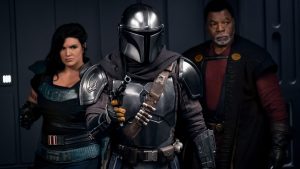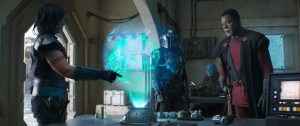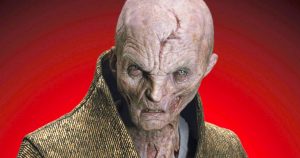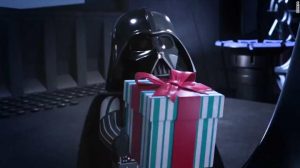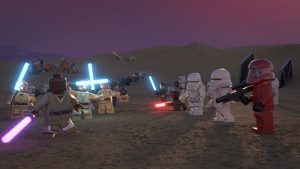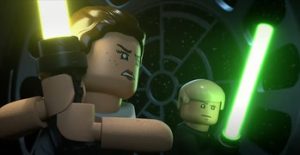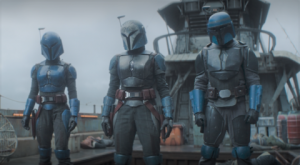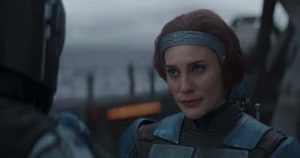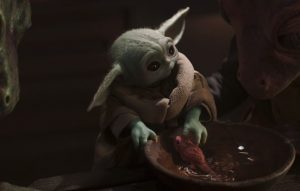SPOILERS FOR THE MANDALORIAN AHEAD!
Yesterday’s episode of The Mandalorian was…not my favorite, for several reasons. I’m over Gina Carano as Cara Dune, I’m growing tired of so many repetitive side-quests, and I’m ready for Baby Yoda to become something more than Din Djarin’s adorable accessory…but one thing that I did find genuinely fascinating and admirable about the episode was showrunner Jon Favreau’s borderline-reckless bravery and confidence, on full display for everyone to see. With a single, subtle reference, he has brought back midi-chlorians, one of the most controversial and universally hated elements of George Lucas’ prequel trilogy, and managed to weave them so deeply into the story that they’re sure to be addressed more directly in the near future as they influence The Mandalorian‘s plot moving forward (if The Mandalorian‘s plot ever moves forward, that is): and now Favreau has to hope that the goodwill he’s built with fans will carry him unscathed through the inevitable firestorm. If he’s lucky, he’ll find the fandom more welcoming to his interpretation of midi-chlorians than they were to George Lucas’ introductory explanation of the concept twenty years ago.

Personally, I don’t expect Favreau to suffer any major consequences for bringing back midi-chlorians, though I do think he could risk damaging The Mandalorian‘s popularity with hardcore fans. Let’s just say, midi-chlorians aren’t something from the prequel trilogy that I think anyone was begging to be reminded of anytime soon, though they have popped up sporadically in Star Wars canon since their appearance in The Phantom Menace. They tend to lead to prolonged philosophical arguments about the nature of the Force: which you might think sounds like fun now, but trust me, you don’t want to be around when Star Wars fans start arguing about…well, anything really. Whether it’s a debate about midi-chlorians or the Skywalker surname, this is one fandom that has always had a massive and well-documented problem with toxic trolls, gatekeepers, bigots, and the like.
Before we go any further, though, I feel obligated to break down some midi-chlorian history and biology for you. Imagine for a moment that you’re Baby Yoda in school on Nevarro; grab a bright blue macaron cookie, and settle in for an explanation of one of Star Wars‘ most complicated, convoluted concepts.
Midi-chlorians, most in-universe scholars agree, are sentient microbes that concentrate inside the cells of every living creature in the Star Wars universe. Most people don’t have very high concentrations of midi-chlorians in their bodies: 2,500 or lower is agreed upon as the normal amount per cell for an average human being in Star Wars. But the more midi-chlorians you have living inside of you, the more attuned you are to the Force (Anakin Skywalker, for example, had over 25,000 midi-chlorians) and the more likely you are to be picked up by some random Jedi passing through town. In fact, during the reign of the Old Republic, that was one of the main objectives of the Jedi Order: taking blood samples from kids around the galaxy, and testing them for midi-chlorians. Now, something important to remember is that midi-chlorians aren’t actually the Force – rather, they act as a conduit between the Force and their host body, translating the will of the Force to their host. The host also has to put in work focusing their mind and looking inwards so as to be more attuned to their own midi-chlorians, and thus more open to the will of the Force. It’s unknown whether the midi-chlorians actually created the link between the Force and living creatures, or whether the Force created midi-chlorians to establish that link (if it’s the former, it leads to some disturbing questions about why the midi-chlorians have an agenda of their own that seems to overpower the free will of their host bodies; but if it’s the latter, why wouldn’t the Force have distributed midi-chlorians more fairly throughout the galaxy?). Midi-chlorians also have a wide range of other bizarre, and only vaguely defined, powers: such as the ability to create life. This has led to speculation that Anakin’s abnormally high midi-chlorian count was a result of him being conceived in his mother’s womb by the midi-chlorians, Immaculate Conception style – and again, we’re getting into troubling territory regarding free will and consent, since Shmi Skywalker doesn’t seem to have gotten any say in this matter.
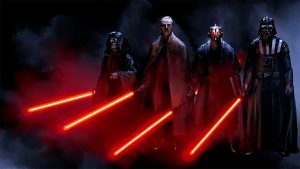
It’s this ability to create and potentially preserve life that caught the attention of the Sith and led to them manipulating midi-chlorians for a variety of evil purposes. Eternal life, for instance, was one of several goals that Emperor Palpatine lusted after – and almost achieved. In The Rise Of Skywalker we discovered that Palpatine was able to survive his death in the explosion of the Death Star II, and since it’s never been fully explained how he managed that (except that it had something to do with clones), it’s been speculated that midi-chlorian manipulation was involved. Now, it looks like The Mandalorian may be trying to retroactively provide more information on this issue – as well as the backstory of Palpatine’s mutant science project, Supreme Leader Snoke (whom I mistakenly referred to yesterday as a clone of Palpatine, when he is in fact a clone created in someone else’s image by Palpatine).
When Din Djarin and his team infiltrated the ex-Imperial fortress in yesterday’s episode of The Mandalorian, they stumbled upon a top-secret cloning facility being operated by Dr. Pershing, a character last seen in season one, whose backstory is largely clouded in secrecy but involves the Kaminoan cloners. Pershing was a minor character, whose agenda in season one was being hindered by having to work alongside “The Client”, an Imperial bureaucrat who didn’t seem to have a very high regard for the doctor’s work, and was mostly concerned with finding Baby Yoda and killing him as quickly as possible. But it seems that ever since the season one finale, with The Client now dead, Pershing has found a more receptive audience in ex-Imperial killing machine Moff Gideon. Unfortunately for Din Djarin, both Pershing and Gideon are working towards a common goal: getting their hands on Baby Yoda, and using him – somehow – to bring about the return of the Empire.
Dr. Pershing isn’t at the fortress when Djarin and his team stage their attack, but they do find a hologram message from Pershing to Gideon’s headquarters, where the doctor gives a progress report on his work, and seems to confirm that, with just a single blood sample he was able to obtain from Baby Yoda back in season one, he’s been trying (so far unsuccessfully) to transfer the child’s midi-chlorians to other beings: all of whom now resemble deformed vegetables lined up in tanks. Pershing never utters the word “midi-chlorian”, but he specifically states that recapturing Baby Yoda is essential because the Empire is unlikely to find any other test subject with a higher “M-count” – a subtle, but unmistakable, reference to the midi-chlorian count. Pershing doesn’t state an exact number that we could compare to other notable Jedi (if Baby Yoda has a higher M-count than Anakin Skywalker, he’s by default the most powerful Force-user on record), but it seems that the child is extremely valuable to the Empire.
But why? What are they doing with all these experiments? Well, we don’t know just yet: but from the context, it certainly looks like Pershing and Gideon are trying to create a small clone army of Force-users, with a small assist from Baby Yoda’s midi-chlorians. The logistics of how a Force-user’s midi-chlorians can be transferred from one person to another is a subject of debate in the fandom – but as I mentioned, we have seen Palpatine successfully clone himself (or something) with his Force powers intact, and we know he created multiple clones of Snoke, a Force user. In The Mandalorian, we possibly even see the very first proto-Snoke in development on Nevarro: according to musically-minded Star Wars fans, his theme plays over a scene in the cloning facility where the camera zooms in on a distorted specimen who has a facial scar very similar to the one sported by Snoke. I have mixed feelings about the revelation that Snoke might have been created using Baby Yoda’s blood, but it’s a twist, alright. What’s more concerning about all this is the implication that this experiment on Baby Yoda was the Empire’s first step towards doing…whatever they did to bring Palpatine back in physical form…and that Baby Yoda’s blood might have been part of that process.
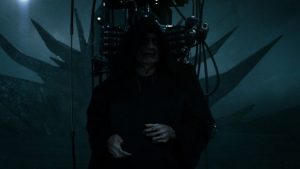
If all goes well, this might also be the first step towards making midi-chlorians popular with fans. When George Lucas introduced the complicated idea in The Phantom Menace, audiences were justifiably confused about why the Force – which, until that point, had seemed like an intangible, spiritual construct – suddenly had a nonsensical scientific explanation: one which seemed to contradict the guiding principle of the original trilogy by suggesting that the Force isn’t something that anybody can wield with the right training, but instead requires you to have a specific number of symbiotic microbes in your blood before you can even take the next step towards becoming a Jedi. It ruins the magic, in a way. And it’s so complex that nobody can figure out exactly what the midi-chlorians are or what they’re capable of, because nobody behind the scenes has ever conclusively answered either of those questions. If The Mandalorian is going to bring back midi-chlorians, it’s going to need to put in the work to explain what they are, what they do, and why we shouldn’t hate them.
So what do you think? Is this a good idea, or a bad one? Are you still trying to figure out the difference between a midi-chlorian and a Mandalorian? Share your own thoughts, theories, and opinions, in the comments below!
